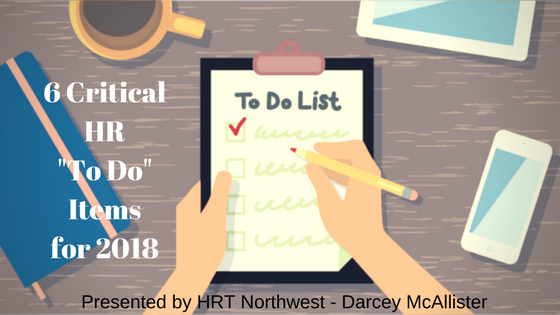6 Critical HR “To Do” Items for 2018
Guest Blog Contributed by Chamber Member Darcey McAllister of HRT Northwest
Ensure harassment prevention practices are up-to-date. Harassment claims continue to dominate the news with a focus moving from the harasser to the organizations who allowed the long-term activity to happen. The best protection is proactive intervention. Review your harassment policy ensuring it contains clear provisions on how to report concerns, train employees on that policy and train managers on how to respond to complaints or concerns. This is the time of year for making resolutions of what we want to fix/change/improve in the upcoming year. I’m sure you already have a list of plans and challenges but adding (and completing) these tactical and strategic “to do” items for your human resources function will assist with compliance and relieve long-term pain.
- Get your records in order. Reviewing employee files and forms is about as boring a task as you can think of. However, ensuring that files contain correct, current and pertinent information is important. This is especially true for I-9 forms as the Department of Labor has indicated it intends to increase audits across all industries in 2018 and is hiring the staff to deliver on that promise.
- Review your hiring practices. Several recent regulatory trends require employers to revisit their employment applications and interview practices. In some municipalities (Portland, OR being one of them) it is no longer legal to ask about criminal convictions until after a conditional job offer has been made. In addition, many jurisdictions now prohibit employers from asking about salary history; rather, you should ask about expected salary. Thus, employment applications should be updated to remove any prohibited information and interview processes should be reviewed to ensure interviewers are not asking for prohibited information.
- Develop a job candidate pipeline. Speaking of hiring, 2018 promises to continue to be a job seekers market, meaning that companies will continue to struggle to fill open roles. Developing a “candidate pipeline” by actively reaching out to people who you want to work at your organization – regardless of whether you have a specific job open currently – will ensure you have a list of quality candidates when a role does become available.
- Schedule a plan to appreciate your employees. On the flip side, to prevent other organizations from raiding your employees means you want them to think they are in the best place now. Managers often equivocate “appreciation” to “spending money” which is not always the case. Simple, meaningful actions such as thank you notes to people who have earned them, team lunches to celebrate meeting milestones or giving top performers stretch goals can mean as much as a raise. The key is to do it regularly and what gets on your calendar gets done so set aside time each week to do something to appreciate someone.
- Evaluate what data you hold and how it is secured. We all know that business owners and HR practitioners are responsible for securing the data they hold on their employees. But with the implementation of GDPR (General Data Protection Regulations) for businesses doing business in the European Union, 2018 is sure to see a hyper-emphasis on data protection and control. Get ahead of the game and ensure you know what data you hold on your employees, understand the justification for holding the data and ensure it is secured from potential breaches or loss.
Managing employees is rarely at the top of most people’s priority list but these simple “to-do” items centered around your people and human resources function could be key to a successful 2018.

